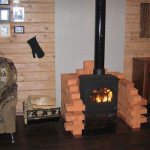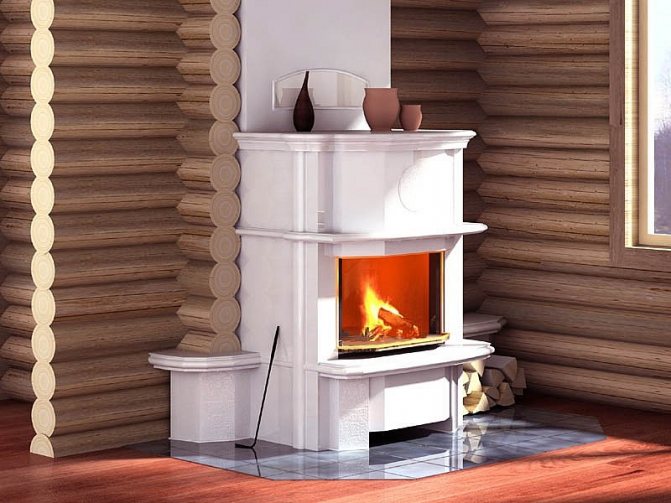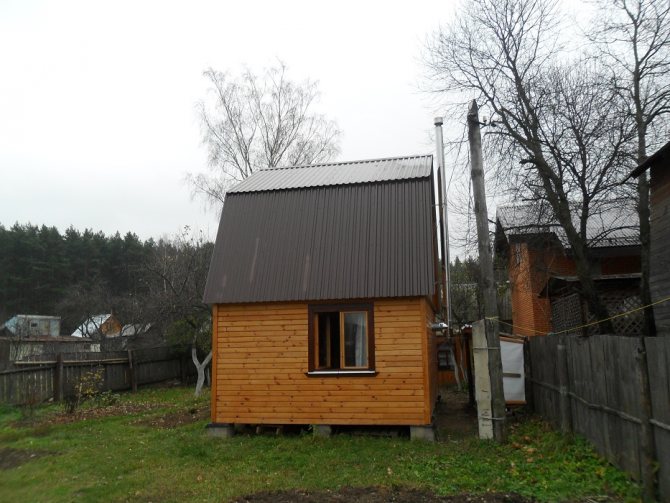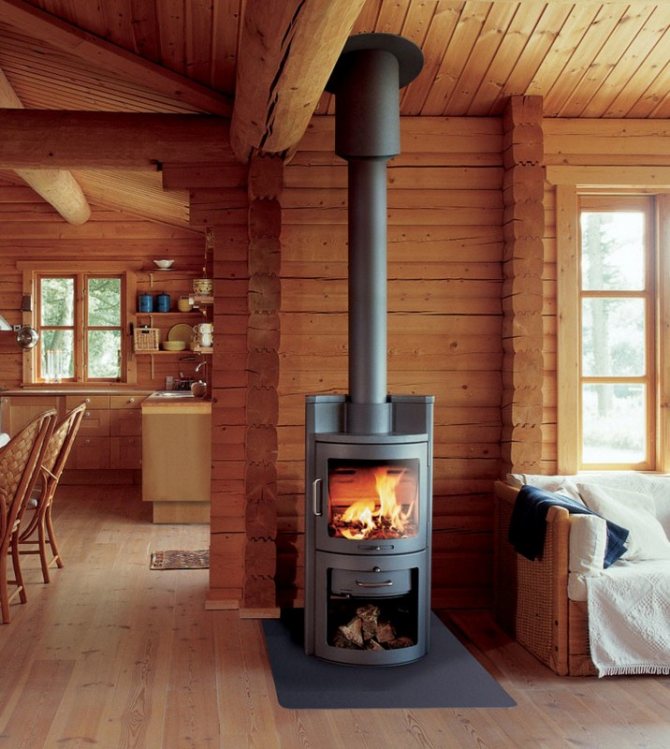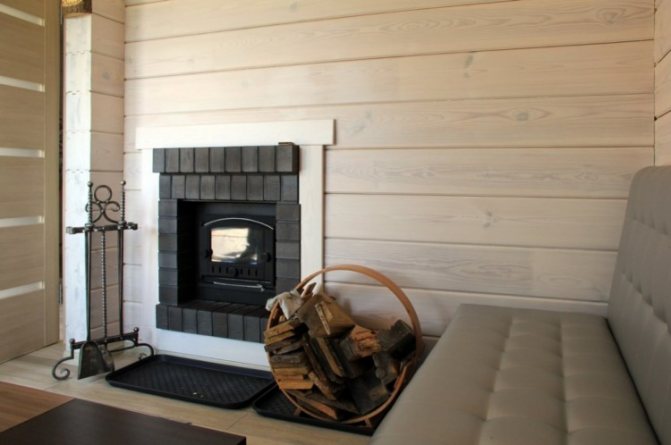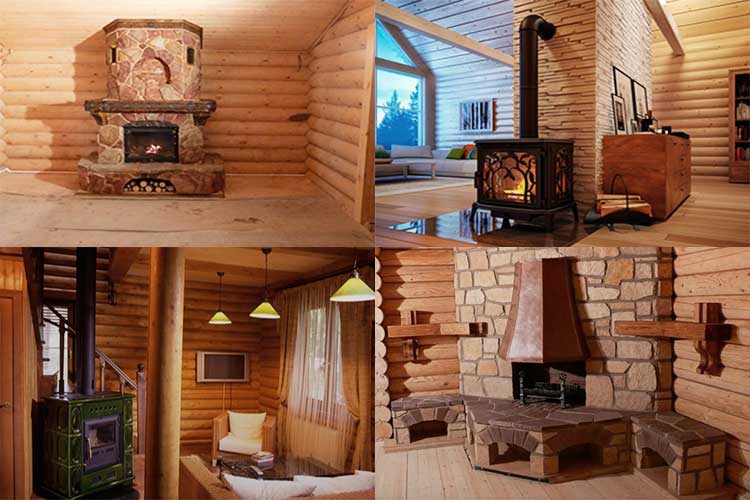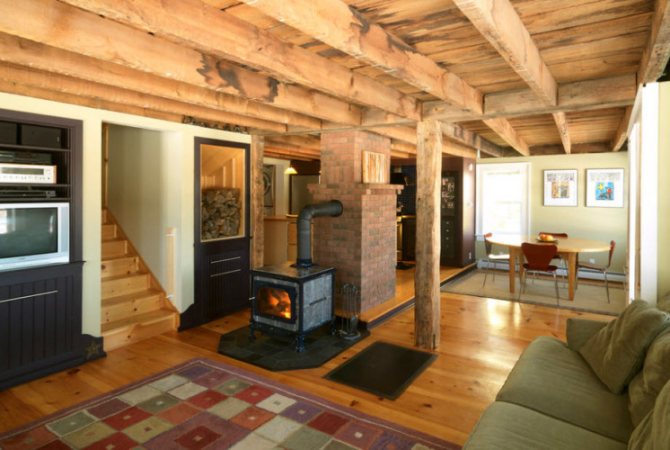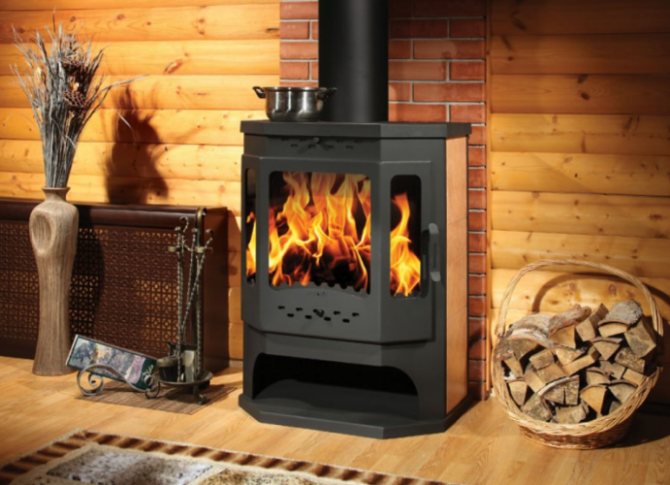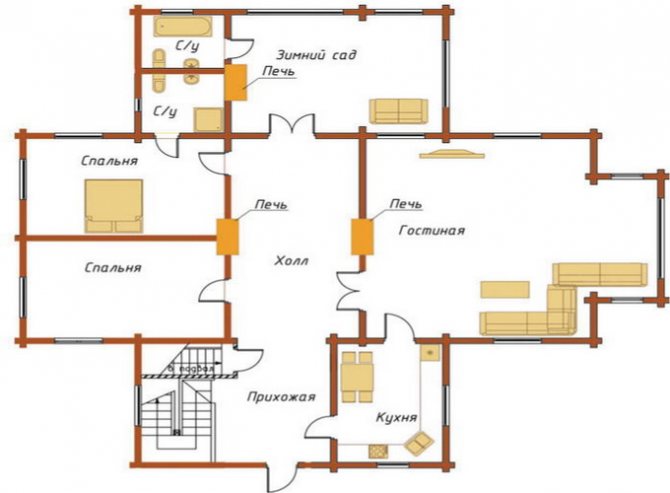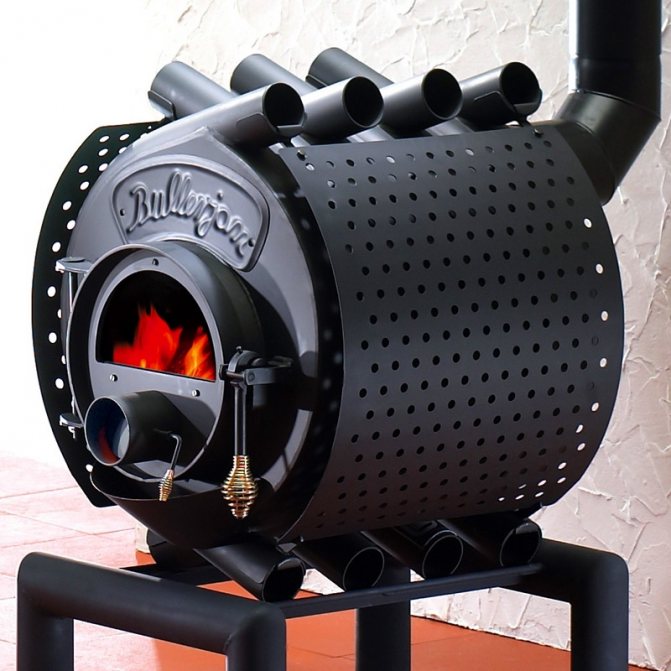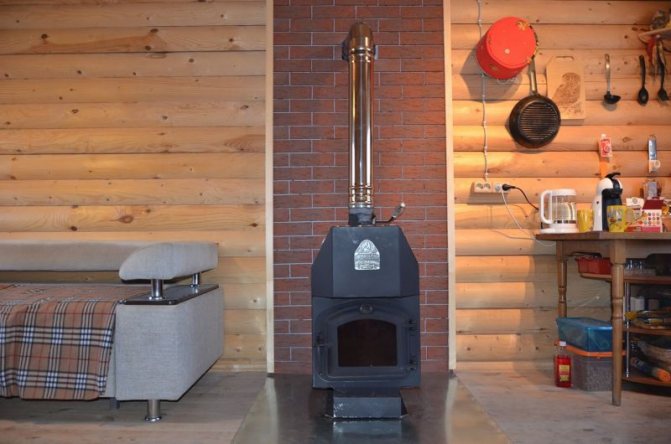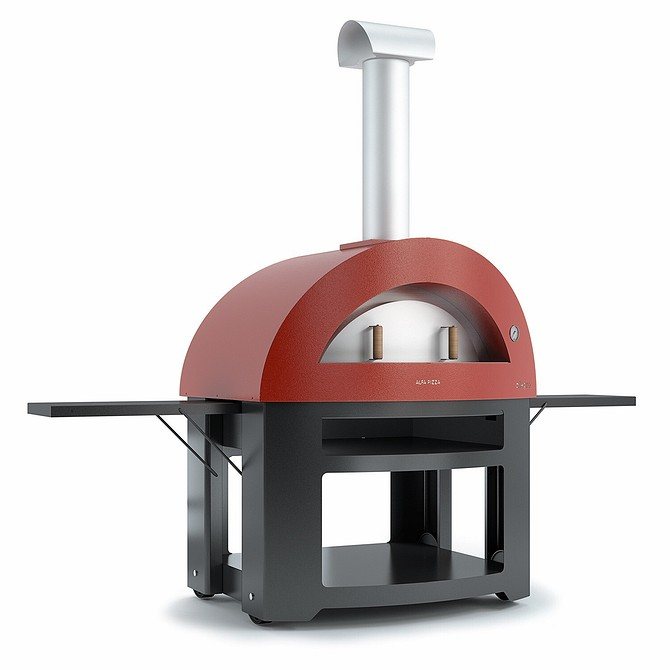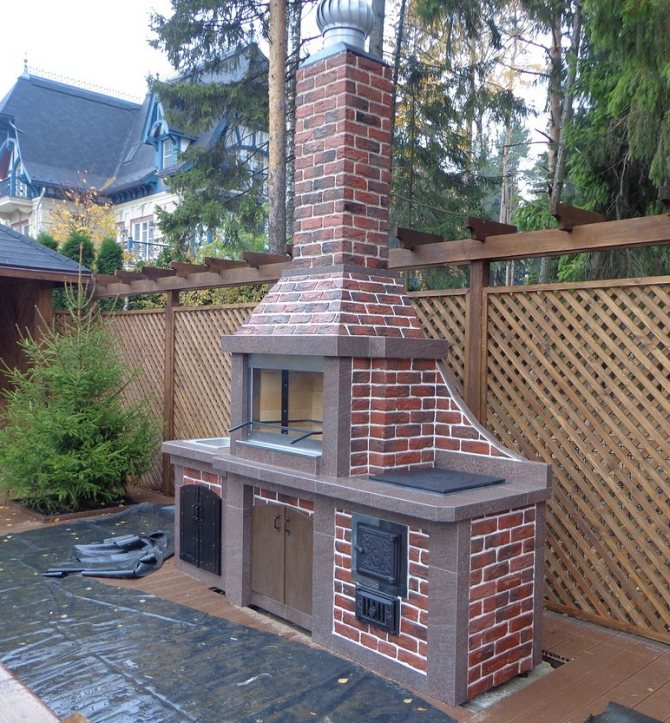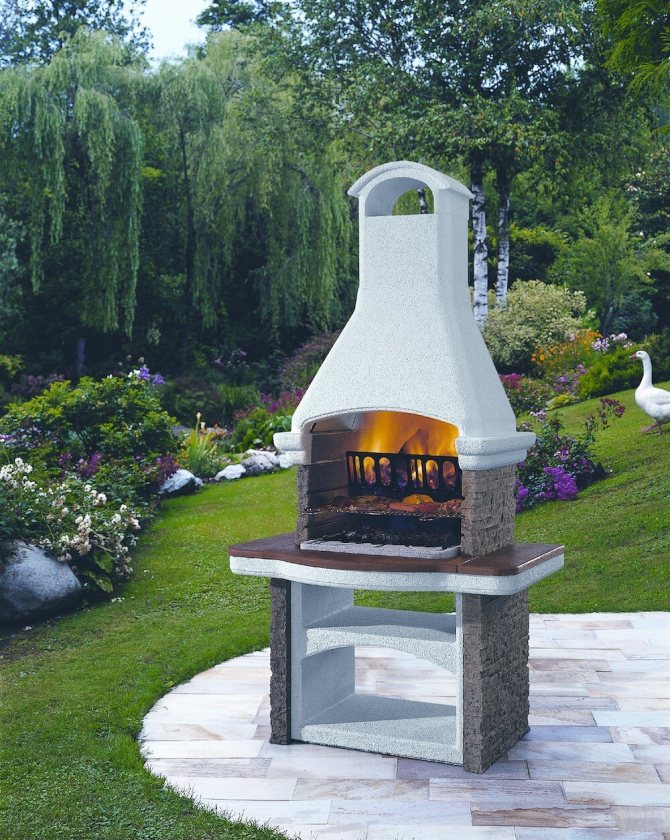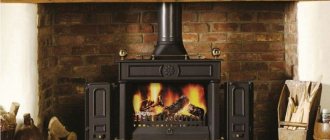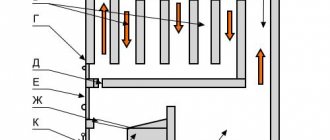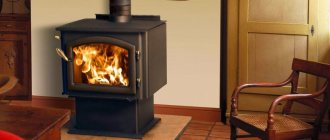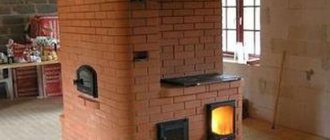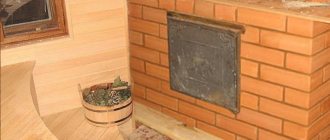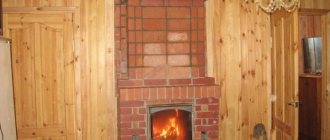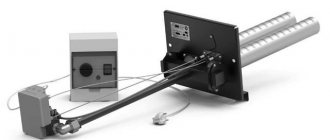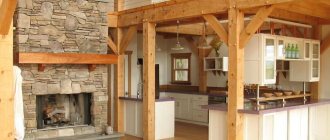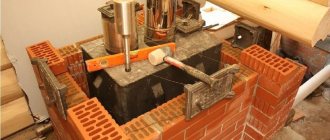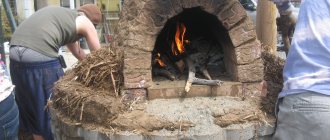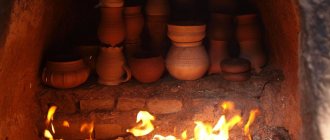The location of the stove in a wooden house
The specific place for installing a metal stove in a wooden house is chosen taking into account the peculiarities of its operation. At the same time, it is important to provide for the possibility of installing a chimney and access to the stove for further maintenance. Do not forget about fire-prevention indents - the hot surface should be located at some distance from flammable materials.
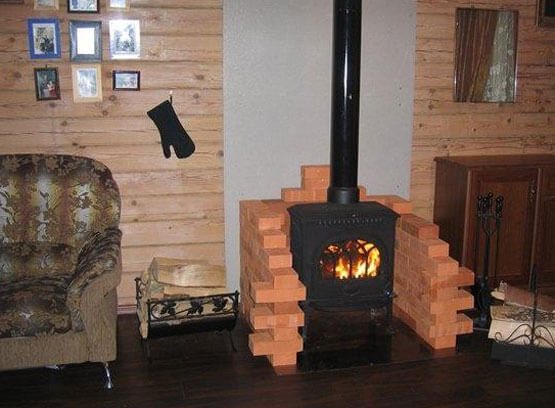
Based on which stove to install in a wooden house, the work is carried out in this way:
- The iron stove that heats the air (Russian "potbelly stove" or Canadian "buleryan") is positioned so as to ensure the free movement of convection currents. In particular, to heat two adjacent rooms, a metal stove in a wooden house can be built into an interior partition or air ducts can be connected to it.
- If a water heat exchanger is installed in the furnace, then its section passing through the heater must be the lowest point of the system. Where exactly the oven will be installed is not so important. The main thing is to observe fire safety techniques.
The installation of a fireplace stove in a wooden house should be carried out so that the chimney can be freely connected. At the same time, it is very important to carry out all work in accordance with the PPB.
In the process of further operation of the iron stove, it will need to be serviced - to clean the combustion chamber, remove ash, periodically remove soot from the chimney. Therefore, a sufficient distance must be left in the direction of opening the firebox door. Please note that if a panoramic glass is provided in the oven, then its installation is carried out taking into account this feature.
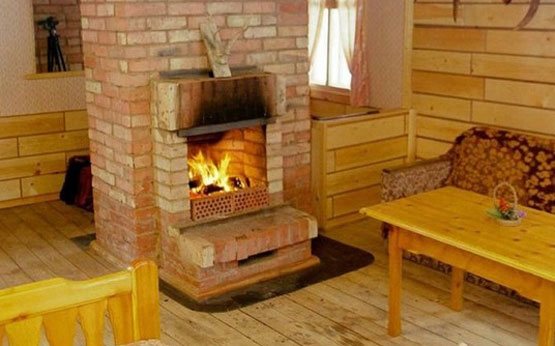

Fire breaks, that is, the indents from the heating surfaces to the wooden walls, should be at least 110-125 cm. From the side of the combustion chamber door, a gap of 125 cm is left.
In addition, when installing a stove in a wooden house, it is important to choose a place in such a way as to ensure maximum heat transfer, ease of use and maintenance of the equipment, as well as safety.
The device of a classic fireplace
Fireplaces installed in modern houses have collected all the best from those used in the Middle Ages and Russian stoves, which with high efficiency transfer heat to the home.
Fireplaces can be used not only as a source of heat, they can decorate the interior of the room where it is installed.
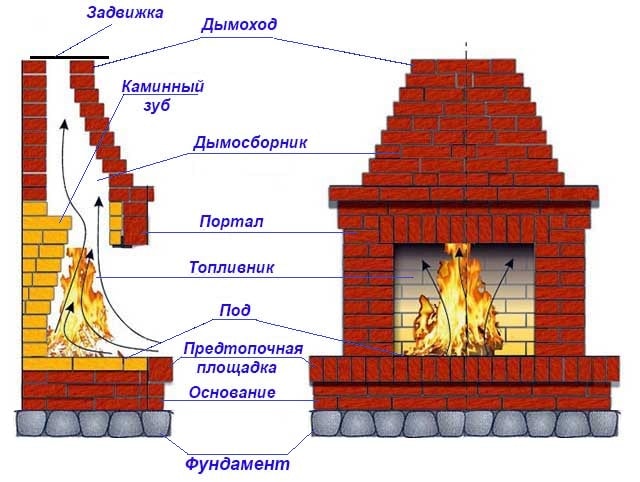

The device of a classic fireplace
Fireplaces installed in modern homes have the following properties:
Cain can be installed directly into the wall, and those that are installed next to the wall. There is another way to install it as an island.
Fuel port type. Fireplaces are open and closed. The first version is a classic version with an open firebox, in the second version, this opening is closed with doors.
The type of fuel used is coal, gas, electricity.
The design of the fireplace directly affects the efficiency. So, the efficiency of an open fireplace is 15%, the closed type shows an efficiency of 70 - 80%. A closed fireplace can act as the only heat source in the house.
Every homeowner can build such a structure in his home, this requires certain knowledge, a set of tools and the ability to work with it.
Some details require special attention:
- design and construction of the base (foundation), the larger the size of the fireplace, the larger the base should be;
- chimney design;
- volume of construction and finishing materials
- the overall appearance of the structure;
- fire safety, fire safety measures must be provided at the stage of design work;
- Tools that will be needed when performing construction work.
- trowel for working with mortar;
- hammer-pick for cutting bricks;
- jointing used to seal the seam;
- building level and plumb line, square;
- a container for preparing a solution and soaking clay.
The need for a foundation for a metal furnace
As a rule, the iron stove is lightweight and easy to install, for which it enjoys well-deserved popularity.
Nevertheless, according to the norms of SNiP, there are a number of conditions under which a foundation is needed:
- If the total mass of the metal furnace does not exceed 80 kg, it is not necessary to fill the foundation for it. However, in this case, the installation of the fireplace in the country is carried out on a solid non-combustible base.
- Heat generating equipment with a total weight of up to 750 kg, in particular, cast iron stoves of medium weight, in accordance with SNiP, is allowed to be placed on a concrete pad. Although there are no strict requirements for the need for a foundation, it is still recommended due to the rather large weight of the furnace.
- Furnace equipment is heavier than 750 kg - in this case we are talking about cast iron units weighing about 300-400 kg. If such a furnace is being installed without cladding, then the foundation for it is not required. However, in cases where a decision is made to impose a brick or natural stone on the heat generator, the mass of the entire structure increases significantly. So, 1 m3 of brick increases the weight of the structure by about 1350 kg. Therefore, the need for a foundation is calculated based on the volume of the facing material.
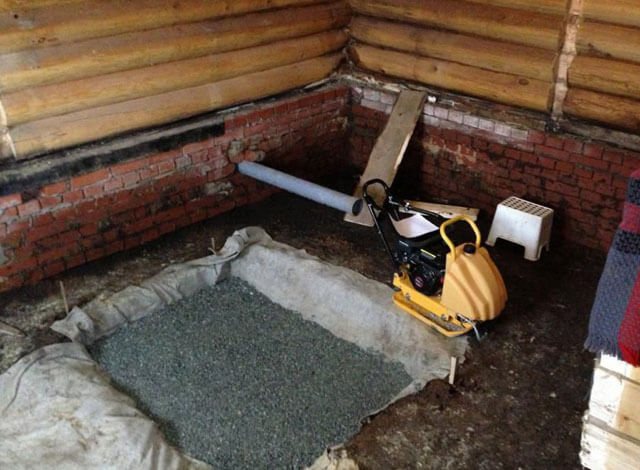

In general, installing a stove in a wooden house with your own hands is not difficult. However, in order to foresee all the subtleties, it is worth consulting with a specialist.
Which heating system to choose
A stove in a wooden house can perform not only the function of the main heating system. Another, no less important, purpose is cooking. Accordingly, according to the type of their use, the furnaces have the following division:
- heating system;
- combined system (heating and cooking).
The second option is often used in homes. However, most owners of suburban wooden houses are content with installing a fireplace, which looks much more aesthetically pleasing than a stove, but loses out in practicality. The main advantage of the fireplace is its economy, therefore many owners of wooden houses prefer to combine the stove with a fireplace.
Do not forget about the safe operation of the heating system. This indicator largely depends on the design of the stove or fireplace.
The following types of heating systems are well suited for settling in a wooden house:
- Classic Russian stove with a stove bench
... Despite the complexity of installation, it is an ideal option.
- Decorative fireplace stove
well decorate the interior of the room. It is a versatile and safe source of heat, thanks to the presence of special heat-resistant glass that separates the fire from the living area.
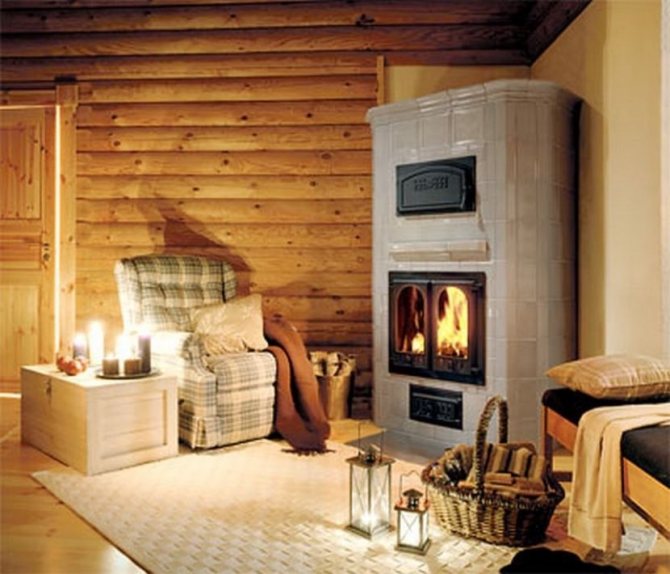

The fireplace stove is equipped with glass doors - and it is pleasant to look at the fire and sparks do not fly in all directions Source bauenhaus.com.ua
- Massive cast iron stove
fits perfectly into the interior of any room. Differs in a variety of models, ease of installation and high fire safety.
Important!
If the choice was made in favor of a fireplace, you must give your preference to a model with a protective glass. The ideal option would be to install a fireplace stove in a wooden house.
Varieties of foundations for the furnace
The choice of the type of foundation for the further installation of the iron furnace is carried out taking into account its characteristics and installation features.
Selection factors:
- The estimate of construction work - the price of materials and the prices of the performers.
- Features of the soil and foundation - the total weight of the structure and the type of soil matter.
- The area of the foundation for the furnace - it affects the type and total weight of the structure.
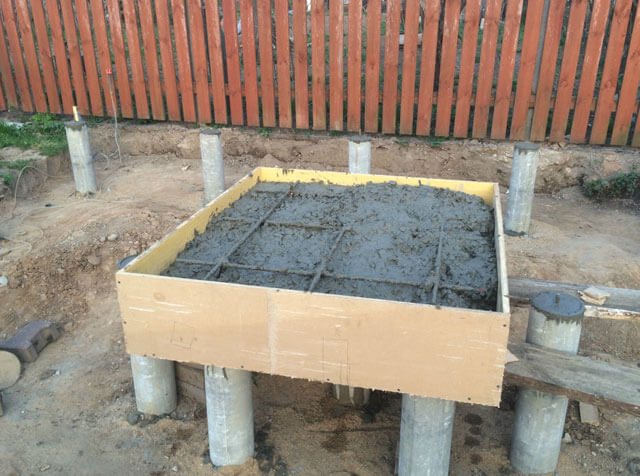

In addition, when choosing the type of base for the furnace, it is necessary to take into account the climatic characteristics of the region and the time of filling, the qualifications and speed of the specialist's work, as well as a number of other initial conditions.
All types of foundations belong to two large groups:
- On poles and piles.
- Concrete bases.
In some cases, the stove equipment can be mounted directly on the floor, while not forgetting the safety rules.
Furnace types
In our country, many types of furnace equipment are built and operated, we will list some:
- Swede
- Dutch woman
- Baby
- Heating and cooking
- Fireplace
- Stove with fireplace.
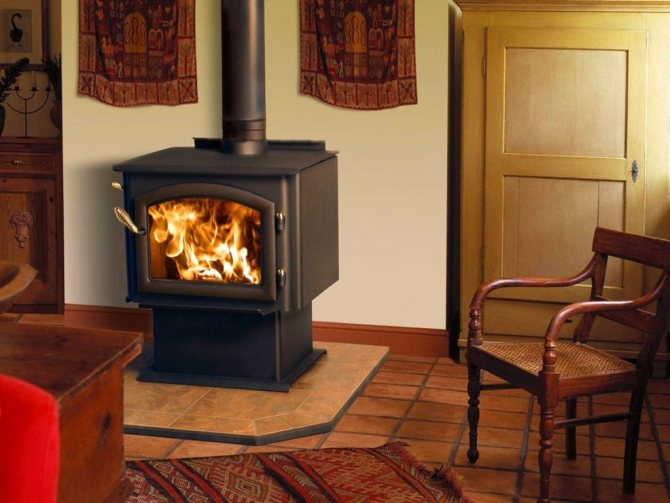

Furnace types
Despite the difference in design, all furnaces are characterized by the following parameters:
- Appointment.
- The maximum heating temperature of the furnace.
- Duration of fuel burning.
- The time it takes to warm up the structure and start full-fledged heat transfer.
- Chimney device.
- The scheme of movement of warm gases through the channels arranged in the furnace body.
- Furnace shape.
- Exterior wall finishing options.
- The material used in the construction of the furnace.
Stoves installed in homes have ancient traditions. Our distant ancestors cooked food on it, heated their homes with it and used it as a sleeping place.
Column and pile foundation
The need for a columnar foundation first arose in those regions where there is a high probability of flooding or there is no dense soil layer close to the surface. Piles are in demand in the construction of multi-storey buildings.
There are three options for arranging a pile foundation:
- Screw pile foundation
... This is a rather expensive option, which, nevertheless, has a high installation speed. In this case, steel screws are used, which are screwed into the ground. They will be the basis of the foundation. At the top, steel piles are tied together and then a concrete pad is poured. The whole process takes 1-2 days.
The screw piles are capable of withstanding even heavy brick-lined cast iron furnaces. True, after 50-60 years, the steel rods rot.
- Bored pile foundation
... First, using a drill, a hole of a given section and depth is drilled in the ground. Its walls are reinforced with mesh, a reinforcing structure is installed and concrete is poured. - Column pile foundation
... The preliminary stage of work is similar to the bored base. However, in this case, ready-made wooden or concrete pillars are hammered into the hole. This type of foundation is used for the construction of multi-storey buildings and the placement of structures with a large mass.
To install a stove in a wooden house with your own hands, it will be easiest to equip a pile foundation. It does not require significant financial costs and is quite within the power of the owner of a country cottage, even if he does not have the skills of a builder.
Please note that the foundation for the stove in the house needs insulation in order to exclude the formation of condensation on its walls for cladding. Uninsulated piles are “cold bridges” and shorten the life of the kiln.
Concrete base
Before installing a metal stove in a wooden house, they most often prefer to pour a concrete foundation with reinforcement.
Among its undoubted advantages are high bearing capacity, ease of independent execution and low cost.
The disadvantages of a concrete foundation include a long time for its arrangement.
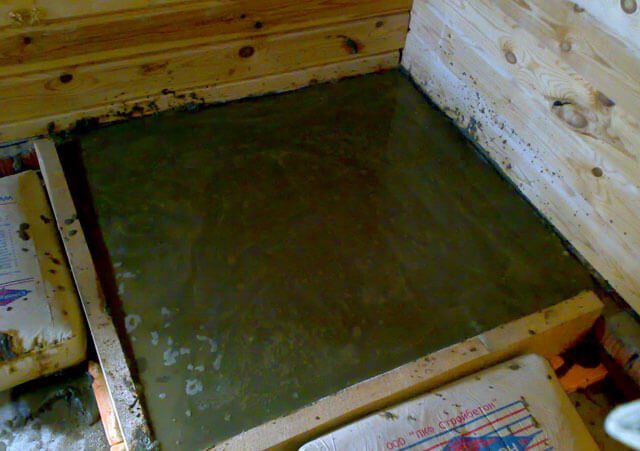

The base for a concrete furnace can be made in two ways:
- Strip foundation
... By the size of the future furnace, a trench is dug around its perimeter, deepening it below the freezing point. After installing the reinforcing mesh, concrete is poured.
Please note that such a strip base should not be associated with the general foundation of the building, since in winter it can be squeezed out of the ground. Sometimes the height of the walls from the ground can reach 20-30 cm, therefore, if there is one solid foundation, the facing masonry on the stove can crack. In some cases, the metal furnace itself undergoes deformation. Be that as it may, SNiP prohibits pouring a common base for the furnace and, in fact, the building.
- Monolithic concrete slab
... To install a fireplace stove in the country, this method is used quite often. The thickness of the slab reaches 15-20 cm, which is enough to obtain a solid base, designed for high loads.
A cushion of a mixture of sand and gravel is first poured onto the previously cleaned area. It is watered and tamped thoroughly. Then a waterproofing layer is laid and beacons are set up for further filling the screed. At the end of the work, the concrete is covered with a film and the next two weeks are poured with water. This is necessary so that the screed does not crack.
Any of the described types of concrete foundation dries up and hardens very slowly. Installation of the furnace with subsequent lining on such a base can be started no earlier than 28-30 days after pouring.
Climate
12 votes
+
Voice for!
—
Against!
For many people, the stove symbolizes comfort. Fire creates an environment that promotes relaxation for the soul. Recently, metal aggregates are in the greatest demand. And the reason for this is both reliability and high technical characteristics. Like any heating device, a metal stove is mounted in accordance with fire safety standards and regulations. Installation requirements in timber houses are undoubtedly more stringent. Proper installation will not only avoid accidents, but will also help to maximize the efficiency of the unit. This article will discuss how to install a metal stove.
Modern heating metal stove
This equipment is widely used for heating baths, summer cottages, working trailers and other small areas.
Metal stove photo
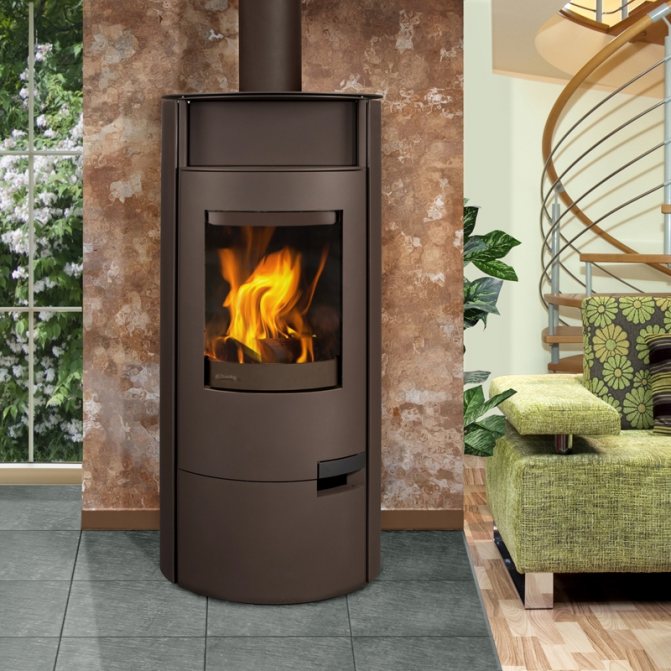

Over the years of "evolution", it has undergone many changes, which positively affected the following parameters and nuances:
- functionality... Today manufacturers offer models that operate in different temperature conditions. Such parameters allow you to choose the optimal microclimate;
- Efficiency. The advanced design allows the choice or combination of different fuel choices, achieving efficient space heating. Due to the increased area of the furnace, the fuel is completely burned, which in turn increases the efficiency;
- equipment. The equipment can be supplemented with a water heating tank, which is important not only for baths, but also for residential buildings in summer cottages or garden plots;
- design. The lineup allows you to choose a product in a stylish design. Ergonomic shapes with high efficiency - the perfect combination. Metal devices are decorated with decorative elements made of glass or forged parts.
Fuel type for metal furnace
This versatile heating source can be operated with a variety of fuels:
- electrical models equipped with a whole range of functions designed to increase the comfort of use (remote control, panel for setting tasks, etc.). Heating elements quickly provide the required temperature.However, with a power outage, you will not be able to enjoy the warmth. It is recommended to install a generator to solve the problem. The cost of such ovens is 12-15 thousand rubles;
- gas equipment thanks to the burner and thermostat, they allow you to adjust the intensity of combustion. It has a reliable security system: automatic sensors and controllers that are triggered in case of force majeure. The units are quite economical, but in the absence of natural gas, it will be necessary to purchase liquefied propane-butane. The price varies between 15-17 thousand rubles;
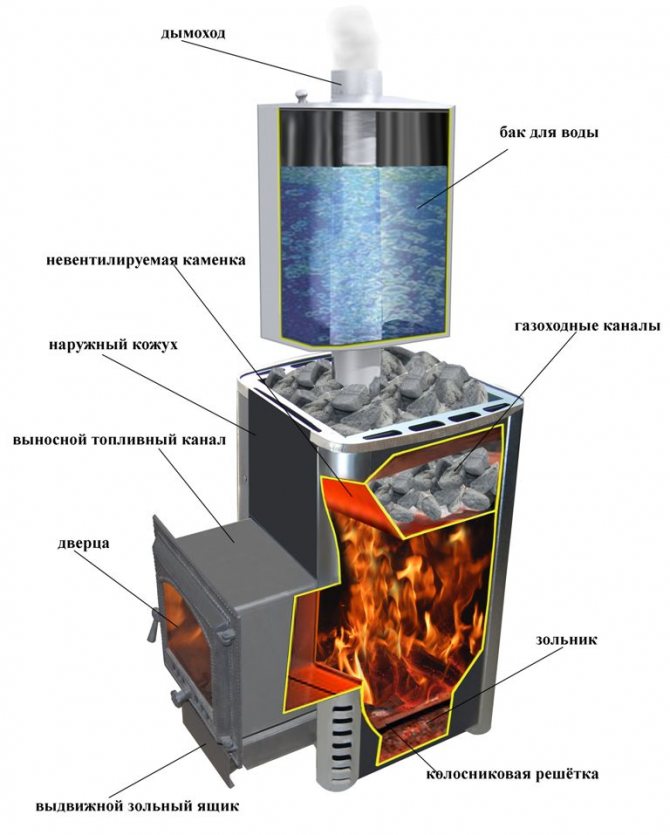

- wood stoves are the most popular. This factor is due to simple maintenance and repair, as well as the available fuel. There are models on the market that imitate a fireplace. The equipment heats up the room rather quickly. Chimneys work to completely remove combustion products. The cost of such heat generators starts from 12 thousand rubles;
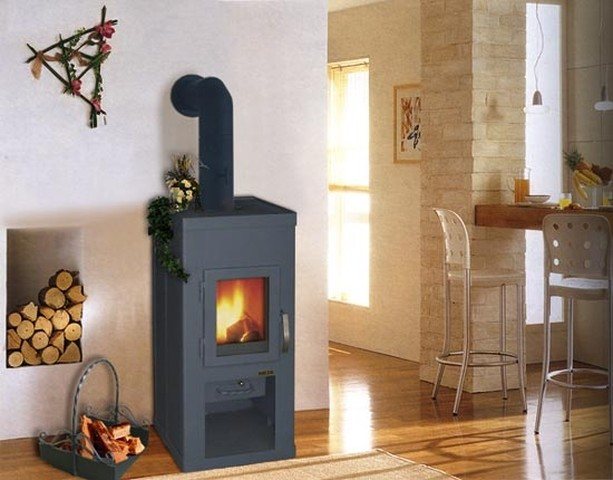

- furnaces fueled by fuel oil, diesel fuel and a special distilled composition, are characterized by a high degree of safety. In addition, such devices are economical in view of the raw materials used. Some models are equipped with a toggle switch for switching from one type of fuel to another. The simplest units will cost only 2,000 rubles.
Choosing a metal stove for your home
A metal oven should be selected based on indicators such as:
- heating rate of a certain area;
- the maximum and minimum temperature that the equipment can support;
- the size of the furnace and the unit itself;
- metal alloy used for manufacturing;
- door modification;
- ease of use and maintenance.
Mainly on the market there are equipment made of cast iron, black and stainless steel. In terms of dimensions, it is divided into:
- mini-ovens with space heating up to 12 sq.m .;
- standard ovens for maintaining the temperature of 12-24 sq.m .;
- large ovens capable of heating air in areas over 24 sq.m.
For cladding, ceramics and talcochlorite are used in their various modifications. Such materials increase the initial heating of the heating equipment, but significantly reduce the unpleasant burning heat and increase the heat release time.
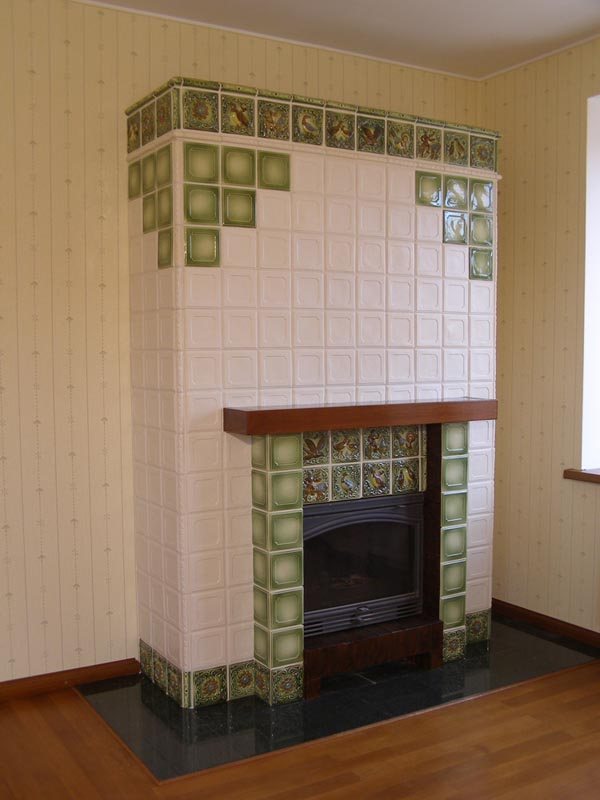

In some models, stone cladding plays only an aesthetic role, without affecting the physical and technical characteristics of devices. Decorative panels are removable, so that it will be easy to dismantle and install products with a new design, radically changing the interior of the room.
Place for installing a metal oven with your own hands
- The technical characteristics of the heating unit are of great importance, but its location is no less important. After all, heat transfer is carried out not only by convective air masses, but also by radiation emanating from the walls of the device.
- If a brick oven gives out weak heat and its walls do not warm up over 90 degrees in normal mode, then the metal product emits a rather hard radiation and the walls of the structure are heated up to 500-600 degrees.
- The place for the installation is determined both during the design of the premises and after the construction of a house, a bath. The main criterion is the location of the window and door openings. Only in this case it is possible to predict in which direction the cold air currents will move.
- Before installation, plan the working space for the fuel. The type of fuel does not matter, it is important to pre-calculate the delivery path and its storage near the heating unit.
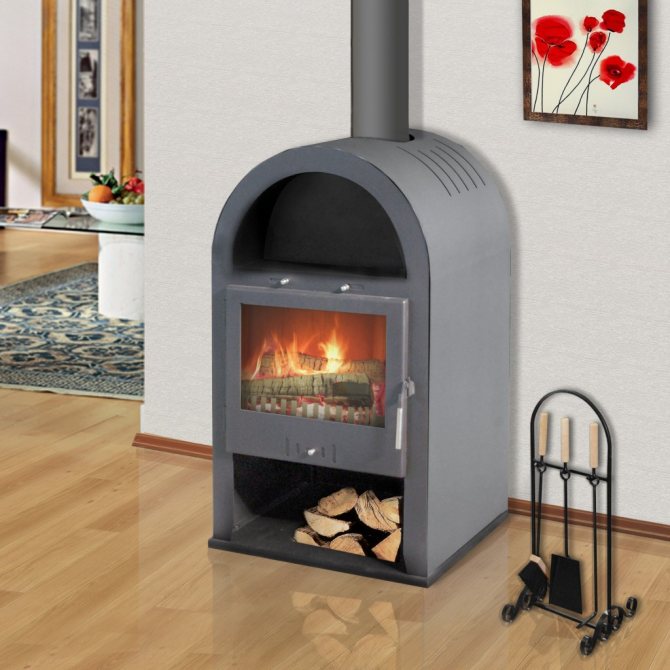

Fire safety
Knowing and observing fire safety measures, it will be possible to install the stove in rooms built from any materials, including wood. Although both brick and block buildings are subject to fire hazards. Therefore, strictly follow all the requirements.
- The unit is installed on a floor lined with non-combustible materials.This can be an ordinary concrete screed, metal sheet, ceramic tiles, etc. The edges of the surface should protrude at least 50-70 cm from the device body.
- The walls adjacent to the stove and adjacent furniture are insulated with a heat-resistant material, for example, asbestos sheets or superisol, thus it is possible to reduce the required distance (1 m) from the wall to the rear wall of the cabinet to 20 cm.
- There should be at least half a meter between the equipment and wooden surfaces (walls or the same furniture), optimally 60-70 cm.
- Much attention is paid to the arrangement of the chimney system. Use additional protective elements that prevent pipe clogging and do not allow birds to build nests, which is especially important for vertically located channels.
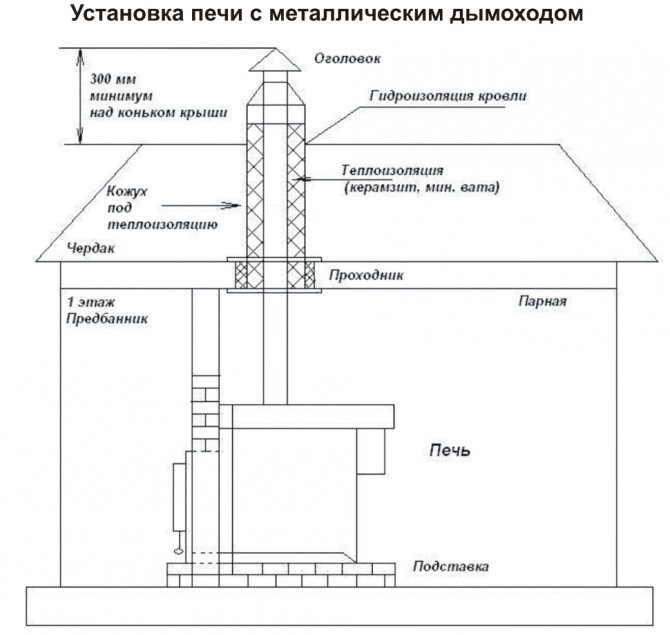

- The distance between the ceiling and the upper part of the casing of the heating unit must be at least 1.2 m, and from the firebox door to the opposite wall - 1.3 m.
- To avoid accidents, especially if there are children in the family, the equipment is fenced off with a decorative “fence”.
- Some models provide for installation of ducts in the walls to heat adjacent rooms. In such cases, heat resistant finishing materials should be used. Recommendations are detailed in the instructions supplied with each unit.
Preparing the floor and walls before installing a metal stove in the house
- Walls protected with insulating materials do not look attractive. Therefore, they are most often decorated with ceramic tiles, and floor slabs from the same collection will help to support the "corner of comfort".
- Ceramics are laid on the concrete floor immediately, and if it is a wooden base, then first a glass-magnesite, plywood or plasterboard sheet is laid. The material is screwed directly onto the floorboards with self-tapping screws. The surface is treated with soil and left for a day until completely dry.
- Tile adhesive is applied with a notched trowel, this tool will allow you to achieve the same layer thickness. The first row is laid as evenly as possible, here a level is used to level the surface both horizontally and vertically. The quality of the entire surface depends on how flawlessly the row is laid.
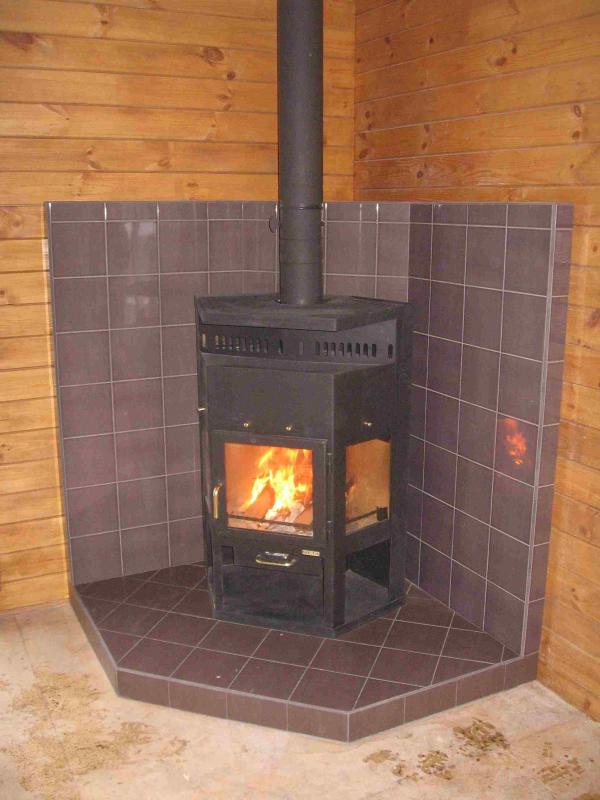

- Ceramic products are mounted without or with seams. The latter option will help to hide layout errors, respectively, decreasing or increasing the distance between them.
- After 2 days, the construction crosses are removed, and the joints are filled with a grout mixture. Decorative sills or corners are used to move from tiles to the main flooring material.
- In the same way, the installation of tiles on the walls is carried out. Heat-resistant mastic is applied to the ceramic with five points. The bottom row does not have to be adjusted horizontally if the floor tiles were installed according to all the rules.
- It is better to trim products to size using a stencil made of thick cardboard. The edges of the masonry are edged with a special profile that matches the sill or skirting board.
Installing a metal stove in a wooden house
Depending on the model, one or another type of connection, assembly of elements will be required. Each manufacturer tries to present equipment with a minimum set of parts. All installation information with detailed diagrams is included with the heating unit.
- In most cases, the equipment only needs to be mounted in a prepared place. The complexity of the installation lies in the correct connection and correctly located outlet of the chimney duct.
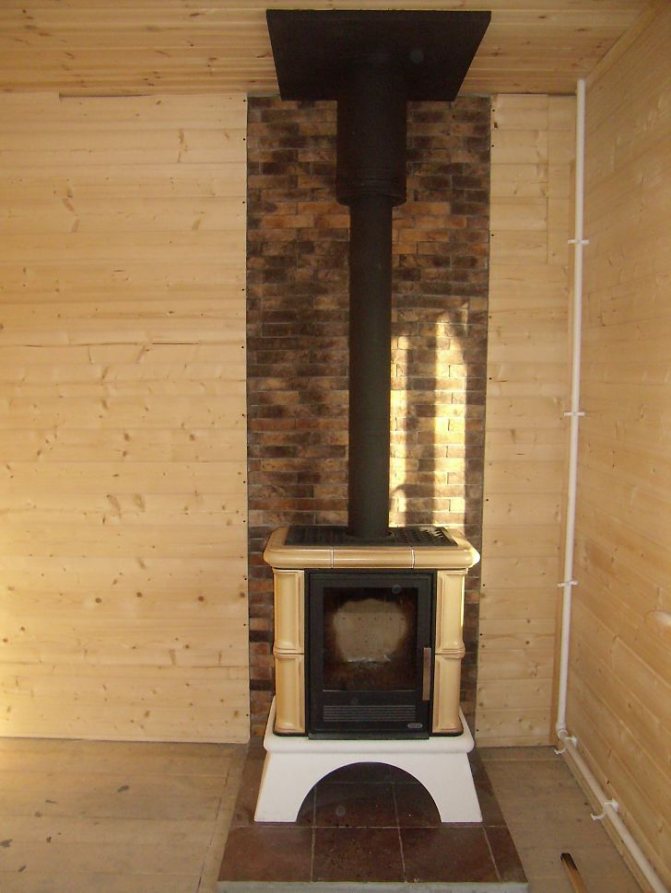

- The chimney can run horizontally or vertically. Due to the large set of pipe elements, it can exit at different angles. It should be noted that the exit through the wall is gaining popularity, but this channel direction is not suitable for all stoves.
- For compact models, double-walled stainless steel pipes with basalt wool insulation are used.These products are characterized by less condensation and less soot settling.
- The preparation of the holes for the pipe is carried out immediately before its installation. To do this, collect the chimney and calculate the point of its exit. The hole diameter should be in accordance with the manufacturer's recommendations.
- If there is a ready-made chimney, then the pipe is passed through the shaft. If the diameters do not match, special adapters (glasses) are used. You should not use complex options for channel direction. Numerous turns will serve as points of accumulation of fuel residues.
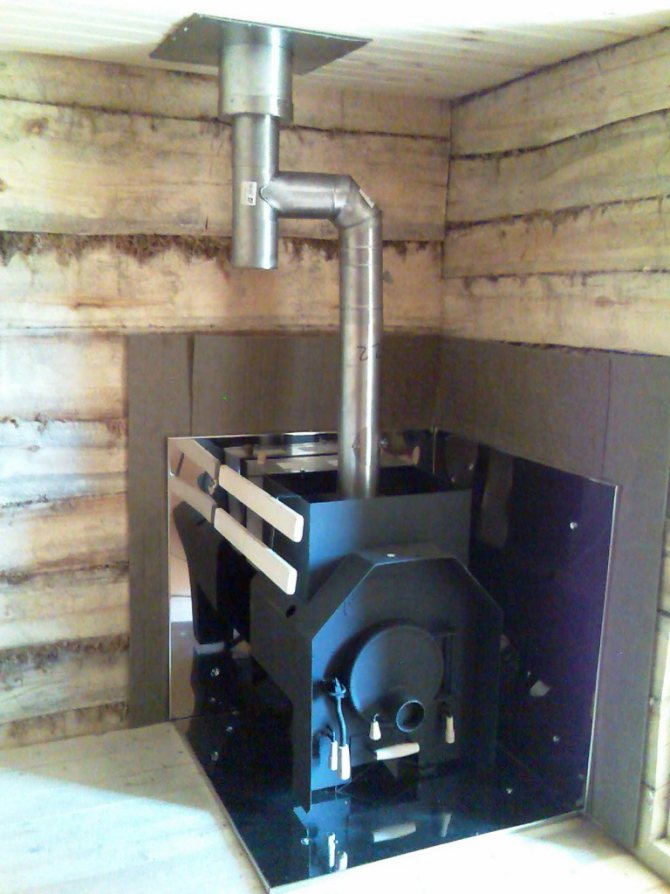

- The chimney begins to be assembled indoors. A pipe is fixed to the outlet of the body, which can be located on top of the body or on its back. A gate is installed above, which serves to regulate the thrust.
- If the channel runs at a slope, then the half-bend with the required degree is used. Heat-resistant materials are used to seal the joints. If necessary, a so-called "glass" is mounted, which connects pipes of different sections.
- A metal plate is mounted at the entry point of the chimney in the wall or ceiling. A technical hole is cut in it equal to the diameter of the channel. This element can be made in the form of a square flange. The height of the boards should correspond to the thickness of the floor or wall.
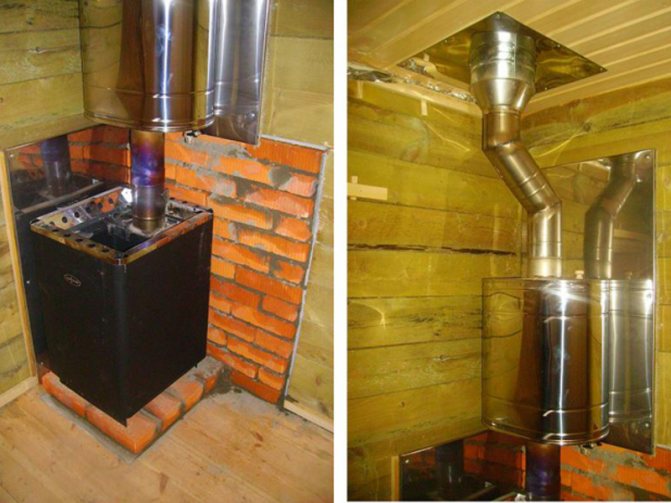

- The resulting "box" is attached to the surface, a chimney is passed through the hole (from the street to the room). The empty space between the flange walls and the double-walled pipe is filled with basalt wool. The double-walled channel is connected to the adapter (glass) with the help of clamping clamps.
- When the chimney exits the wall from the street side, a tee is installed on the pipe, from which a vertical channel will go. Its reliable fastening will be provided by wall brackets. To protect against the ingress of leaves, dry branches, the head is equipped with a deflector. This element will not allow birds to nest at the end of the pipe.
Brickwork for metal oven
A metal stove, for all its advantages, emits too harsh radiation, which does not allow breathing freely in its immediate vicinity. The solution to this problem is to cover the equipment with solid brick masonry.
- Before work, you need to make sure that the floor can withstand an impressive weight, sometimes reaching half a ton. When marking, a gap between the unit body and the future wall of 3-8 cm is observed.
- A metal sheet with a thickness of 2-4 mm is laid on wooden floors, which, in turn, is covered with asbestos. The width of the lining is taken with the calculation of the thickness of the bricks themselves. If the base is made of concrete or ceramic slabs, then there is no need for preparation.
- The walls rise in half a brick. The solution is kneaded on the basis of clay mixed with sand, its density should be of medium density. The work is carried out according to all the canon of ordinary brickwork, that is, in compliance with leveling along the planes and bandaging the seams.
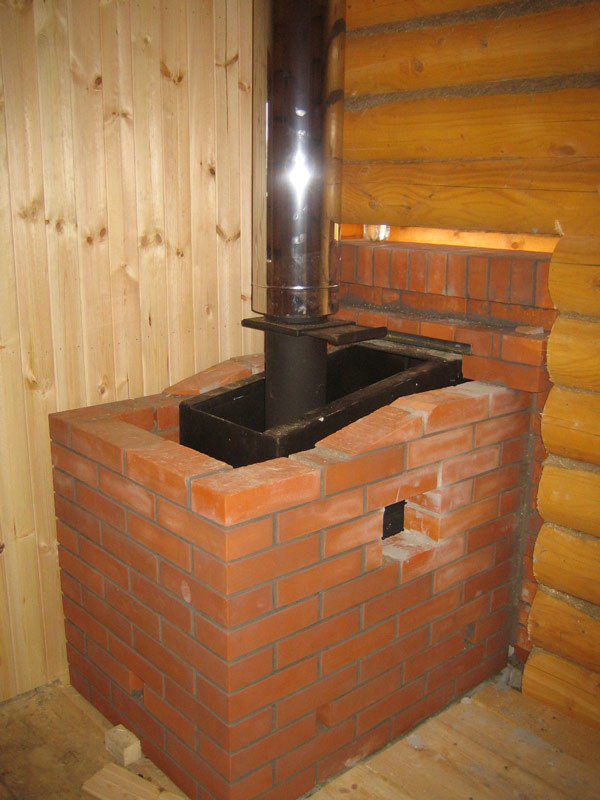

- In the second row, on all 3 walls, technological holes are made, about half a brick for high-quality air exchange. They also leave holes for the blower, door and other structural elements of the furnace.
- When the height of the wall reaches the top of the firebox door, the corners of their metal are exposed on the brick blocks, which will distribute the load given by the subsequent rows. To decorate the top, different options are used, for example: they are left open or performed in an arched form.
The cost of work in specialized firms
- If for some reason you decide to shift all of the above actions onto the shoulders of professionals, then the installation of equipment will cost 7-10 thousand rubles. Installation work in wooden houses will be slightly more expensive. This is due to the additional arrangement of insulation.
- The price of laying the chimney through the floors and the roof will be from 25 to 40 thousand rubles.depending on the complexity of the work being carried out. If the chimney runs along the outer wall, then you will have to pay about 5-10 thousand rubles for the installation, where the final cost will be determined by the length of the pipe.
- It is, of course, only the owner who can decide to save on work and to install the heating unit by one's own efforts or to seek help from specialized organizations. The main thing is that the installation of the furnace itself and the chimney system is carried out in accordance with fire safety standards.
Compliance with the rules will help to avoid dire consequences, we are talking not only about the possible loss of real estate, but also the health and lives of relatives and friends.
Installation of the oven on the floor
As already mentioned, a metal or cast-iron stove in a wooden house can be installed without preliminary pouring the foundation, if its weight, together with the facing material, does not exceed 750 kg.
According to building codes, it is allowed to install a fireplace on a wooden floor if it is not cladded. For installation on the second floor of a building, supporting structures must first be reinforced with a channel or metal corners.
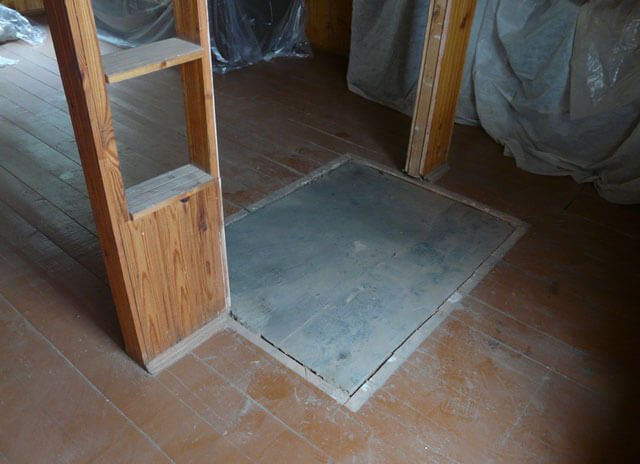

To protect the wood from fire, a metal sheet or a brick layer is placed under the stove. This process does not present any additional difficulties.
The instructions for heating devices always describe in detail the technology for their installation and provide recommendations for connecting to the chimney.
Advantages and disadvantages
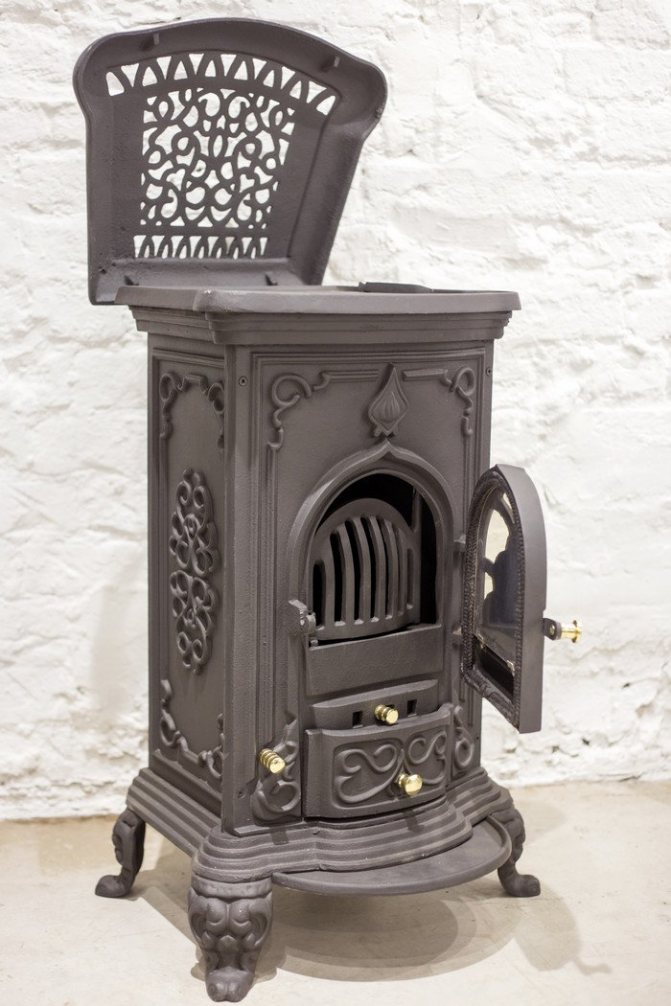

The industry offers two types of metal furnace units. Country wood stoves are made of steel or cast iron. Cast iron heaters are more expensive, but they have a number of advantages that cannot be achieved in the manufacture of steel products. Cast iron wood stoves for summer cottages have:
- long service life, which, with proper operation, can reach 30 - 40 years;
- high heat capacity and therefore retain heat longer compared to steel furnaces;
- greater corrosion resistance in comparison with steel products, they practically do not rust with frequent "cold" firebox;
- Due to the low coefficient of thermal expansion, cast iron furnaces are not subject to warpage and deformation.
It should be said that cast iron has an attractive appearance. Often, manufacturers' design solutions make it possible to turn an ordinary heater into a real work of art. Many cast iron stoves become a decoration of the interior of the room in which they are installed.
Cast iron is a rather fragile material and is afraid of sharp blows from which it can crack. Also, cast iron is "afraid" of heat shock. Cold water spilled on a hot stove can cause the metal to crack. Therefore, a cast iron stove with a hob must be of a design that excludes direct contact of the flame with the stove.
When choosing a method of heating a country house, one must proceed from the fact that it is impossible to uniformly heat the air in all rooms with the help of a cast iron heating apparatus.
A cast iron stove can provide full heating in only one room. Installing cast iron furnace units in such a way that they heat several rooms is prohibited by fire safety rules.
Compared to brick stoves and fireplaces, cast iron heaters have one important advantage. With a comparable thermal power, cast iron units have an order of magnitude less weight. If a brick stove weighs one ton, then the weight of a cast iron stove will be about 100 kilograms.
Therefore, the installation of a cast-iron heating device does not require the construction of a foundation. It can be installed directly on the floor. Naturally, for fire safety purposes, it must be installed on a metal sheet or a platform made of non-combustible material.
Chimney installation in a wooden house
When fuel burns inside the fuel chamber of the furnace, a temperature of 450-550 ℃ is reached, while the chimney heats up to 300 ℃. If a fire occurs as a result of the accumulation of soot, the temperature inside the chimney can briefly reach 800-1000 ℃. In this regard, when installing steel chimney pipes, fire breaks must be observed.
To understand how to properly install a stove in a wooden house, you should be guided by the following PPB:
- It is recommended to use a ceramic and stainless steel sandwich pipe with a layer of thermal insulation as a chimney.
- The pipe should run at a distance of 25 cm from the walls near the walls. The walls themselves should be covered with basalt cardboard with galvanized or stainless steel sheathing.
- The opening in the ceiling for the chimney to pass through the floor slabs must be sufficient to leave 25 cm on each side from the chimney to the combustible material. The resulting gap must be filled with basalt insulation. If desired, you can install a factory-made ceiling cut.
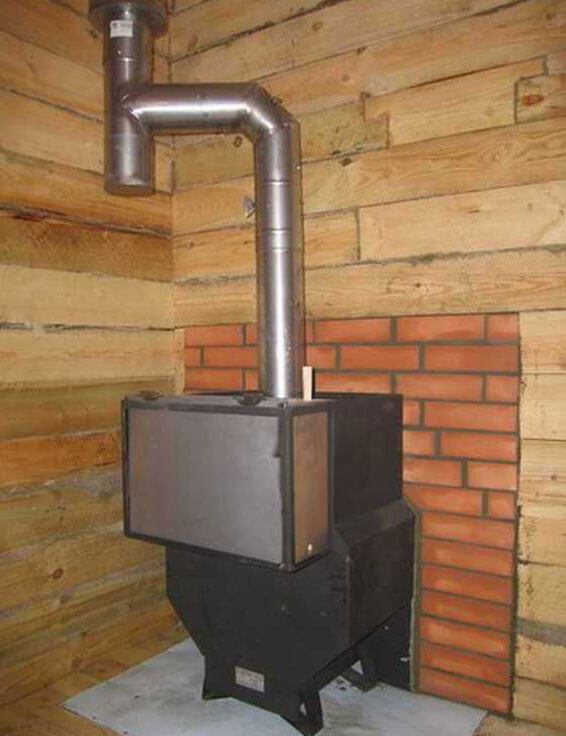

The chimney can pass both inside the building and along its outer wall. Inside the house, it is necessary to provide high-quality insulation of the pipe in the places where it passes through the ceiling and roof. From the outside, the pipe must be carefully fixed to the wall of the building so that it is not blown away by the wind.
Furnace installation
- The furnace is being installed at the prepared place. The equipment comes with documentation and the necessary parts for installation. The main difficulty is the phased formation of the chimney:
- The direction of the pipe can be horizontal or vertical. The exit goes through the wall or ceiling.
- Double-walled pipes are used, between which basalt wool must be laid. The chimney system is being assembled and the location of the hole in the wall or ceiling is calculated.
- A chimney pipe is mounted to the upper part of the body.
- A gate is installed to adjust the draft.
- In the case of an angled pipe, a half-elbow is used.
- A sheet of metal is attached to the ceiling. A hole is made in it, equal to the diameter of the pipe.
- A chimney is passed through it, and basalt wool is inserted into the free space (from the sides).
- If the exit of the chimney is planned into the wall, then a tee is attached outside. A vertical pipe is inserted into it and it is fixed with clamps to the wall of the house. A deflector for collecting garbage is mounted below.
Fire safety rules when installing the furnace
According to fire safety regulations, before installing an iron stove in a wooden house, care must be taken to protect the floor and walls made of flammable materials from fire.
To do this, use:
- fire-resistant heat-insulating materials mounted on walls and ceilings in the area where the furnace is located;
- fire retardant impregnations and mastics.
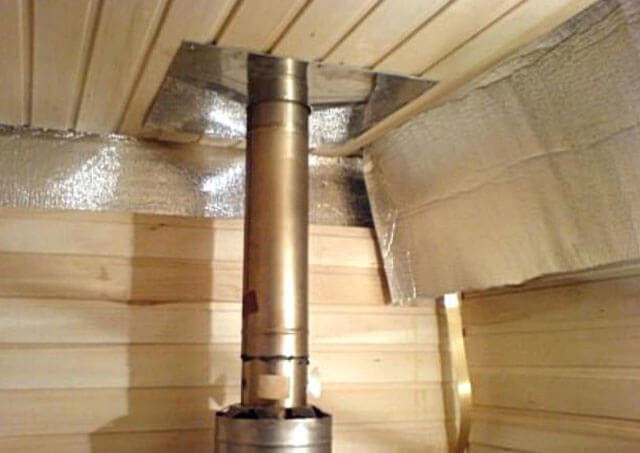

Compliance with fire regulations and the use of fire protection equipment is the main condition for the safe operation of solid fuel equipment.
Preparing for installation
Do-it-yourself stove heating equipment for summer cottages begins with preparation:
- The walls and floors closest to the appliance are covered with ceramic tiles.
- If the floor is wooden, then at the first stage drywall is placed on it. Then the ceramic tiles are attached with self-tapping screws. A layer of primer is applied on top, and drying takes place within 24 hours.
- If the base is concrete, then the tile is placed directly on the glue.
- When using tile adhesive, a notched trowel is used. The ceramic layer is laid out using a level.
- The tiles are laid end-to-end or with a gap using construction crosses.
- After the solution has solidified, the crosses are removed and the joints are overwritten.
- Wall tiles are laid using the same technology.
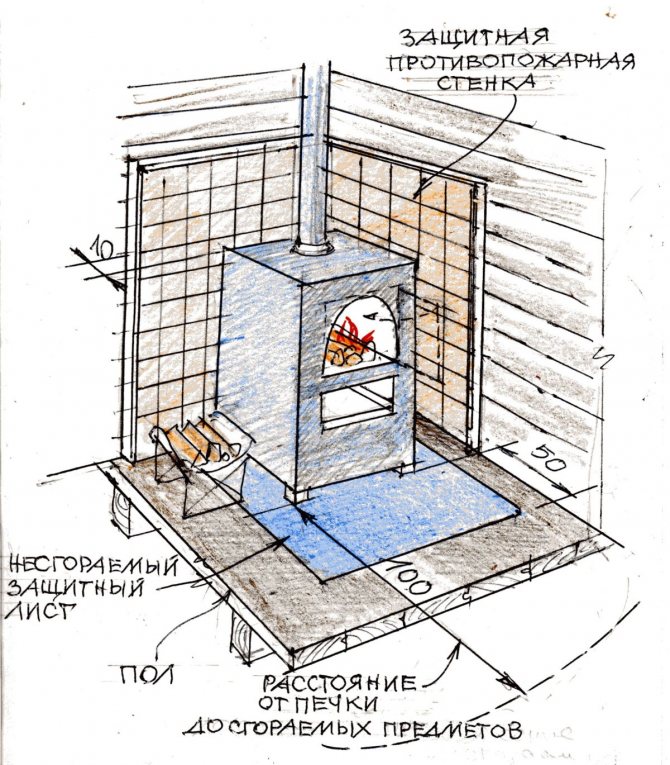

Scheme of an example of installing a furnace in a bath
Protective wall and ceiling cladding
The walls directly adjacent to the stove, as well as part of the ceiling along the passage of the chimney, are subject to significant thermal loads.
Therefore, before installing the stove in a wooden house, you need to fulfill a number of prerequisites:
- Ceiling lining is made of non-combustible material. Do not use wood or plastic panels. It is best to purchase gypsum fiber boards treated with gypsum plaster for painting.
- The walls should be protected with a layer of basalt cardboard and sheathed with a sheet of steel. Alternatively, you can use ready-made decorative stainless steel screens. These products are capable of providing safety and are distinguished by their external beauty. In addition, walls can be plastered with a layer of 3 cm or more, as well as bricked (read: "How to brick a metal stove in a house - step by step guide").
In more detail, the fire safety rules for the installation of iron stoves in wooden houses are described in SNiP 31-05-2003 and SP 118.13330.2012.
Installation of chimneys
The installation of stoves and fireplaces in a wooden house necessarily implies the presence of chimneys. Installing them at random is like making a fire inside a wooden house. The thing is that during the operation of the furnace heating system, a short-term temperature can occur in the chimney, which sometimes exceeds 800 degrees. For this reason, fire breaks must be provided in chimneys.
Chimney installation is carried out in accordance with the rules:
- the chimney is made of refractory bricks, stainless steel or ceramics, which has a heat-insulating layer;
- it is not advisable to place the chimney close to the wall. The places where the chimney pipes will pass must be covered with thermal insulation;
- the junction of the pipe and ceiling is insulated with basalt cardboard, stainless steel or galvanized sheet.
Wood treatment against fire
Additional means of protecting wooden structures located in the immediate vicinity of the iron stove are flame retardant impregnations and mastics. Beams, supporting structures, floors and walls adjacent to the furnace are subjected to such processing. The mastic has a higher level of fire protection, and the impregnation is practically colorless.
Fire retardant treatment can be carried out both by representatives of the Ministry of Emergency Situations and the owners of a wooden house. In the latter case, before starting the operation of the furnace, it will be necessary to obtain a certificate from the inspector of the Ministry of Emergency Situations on the compliance of its installation with the requirements of the PPB.
All leading European and Russian manufacturers of solid fuel stoves in the technical documentation describe in detail the rules for installing equipment and requirements for fire safety.
How to choose?
The main criterion for choosing a heating device is its thermal power. Heat output is selected based on the area of the room or its volume. Usually, manufacturers in the technical documentation indicate the volume of the room that can be heated using a particular model.
Having decided on the power of the stove unit, you need to decide on its type: a simple stove, "fireplace" or with cooking hobs. When choosing a stove for heating a house, you need to focus on reputable manufacturers with a name.
Among the well-known brands, you can advise:
- Belgian heating units EFEL,
- products of the Polish manufacturer EUROKOM,
- Russian-made products from ARDENFIRE META,
- Italian EdilKamin.

